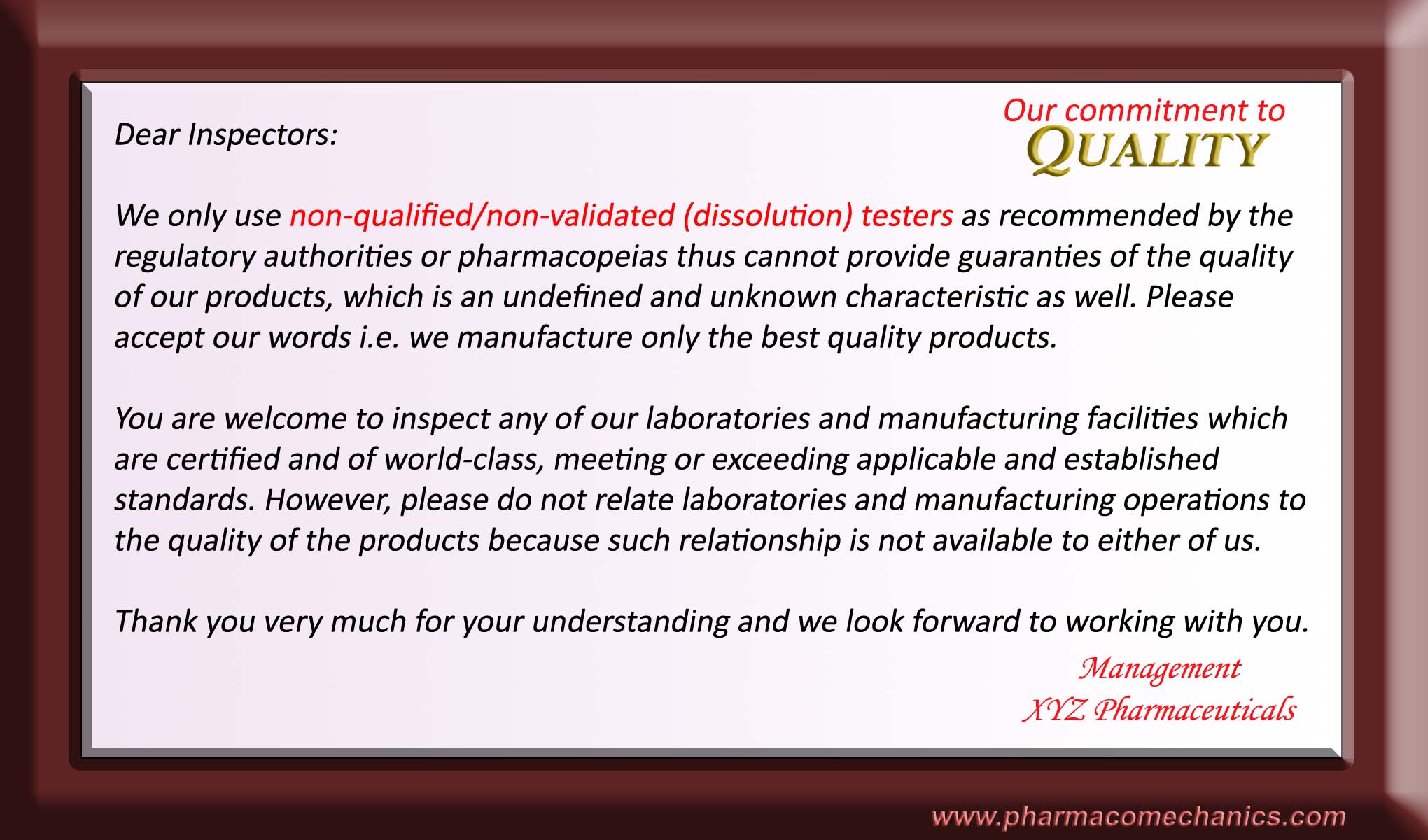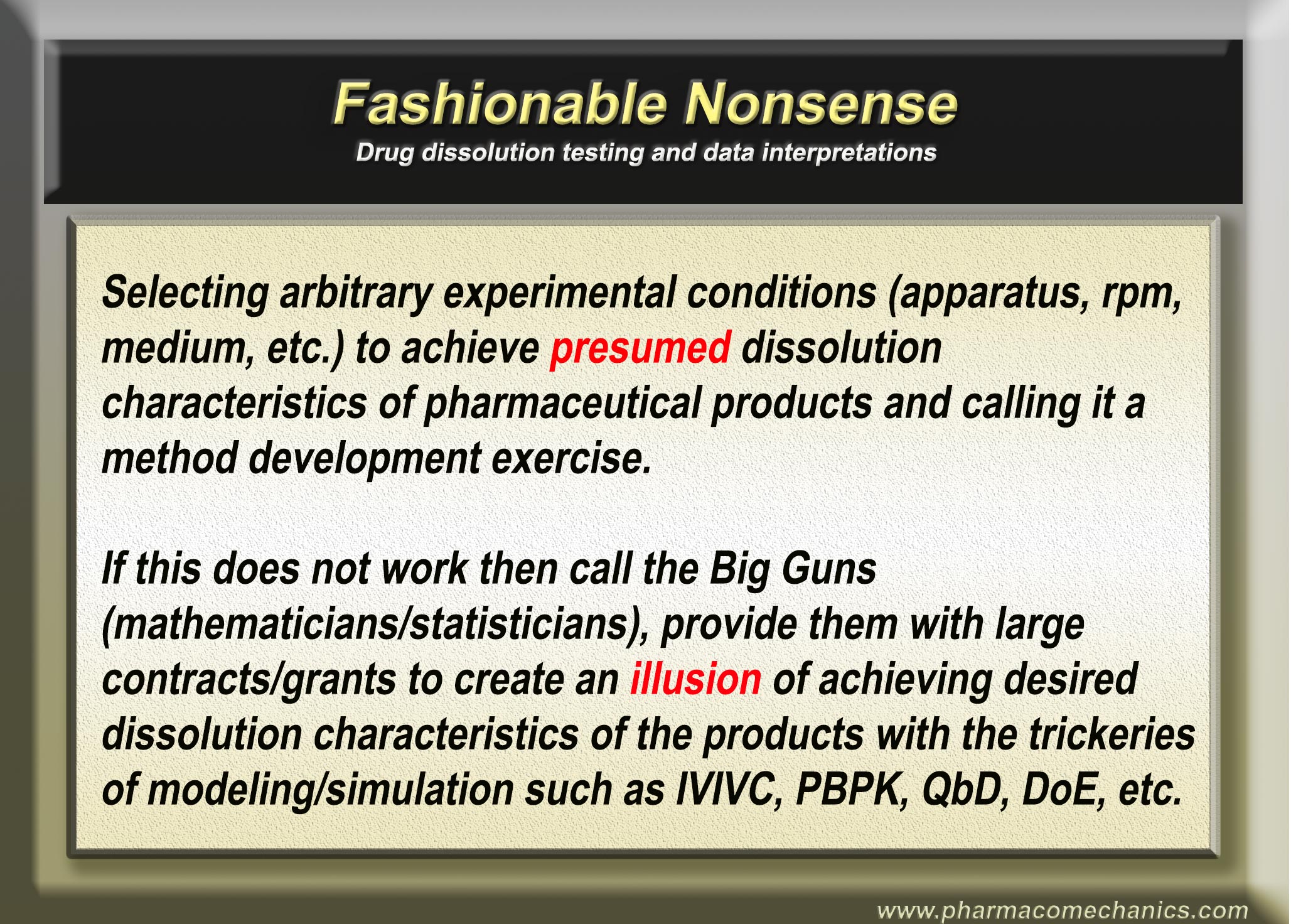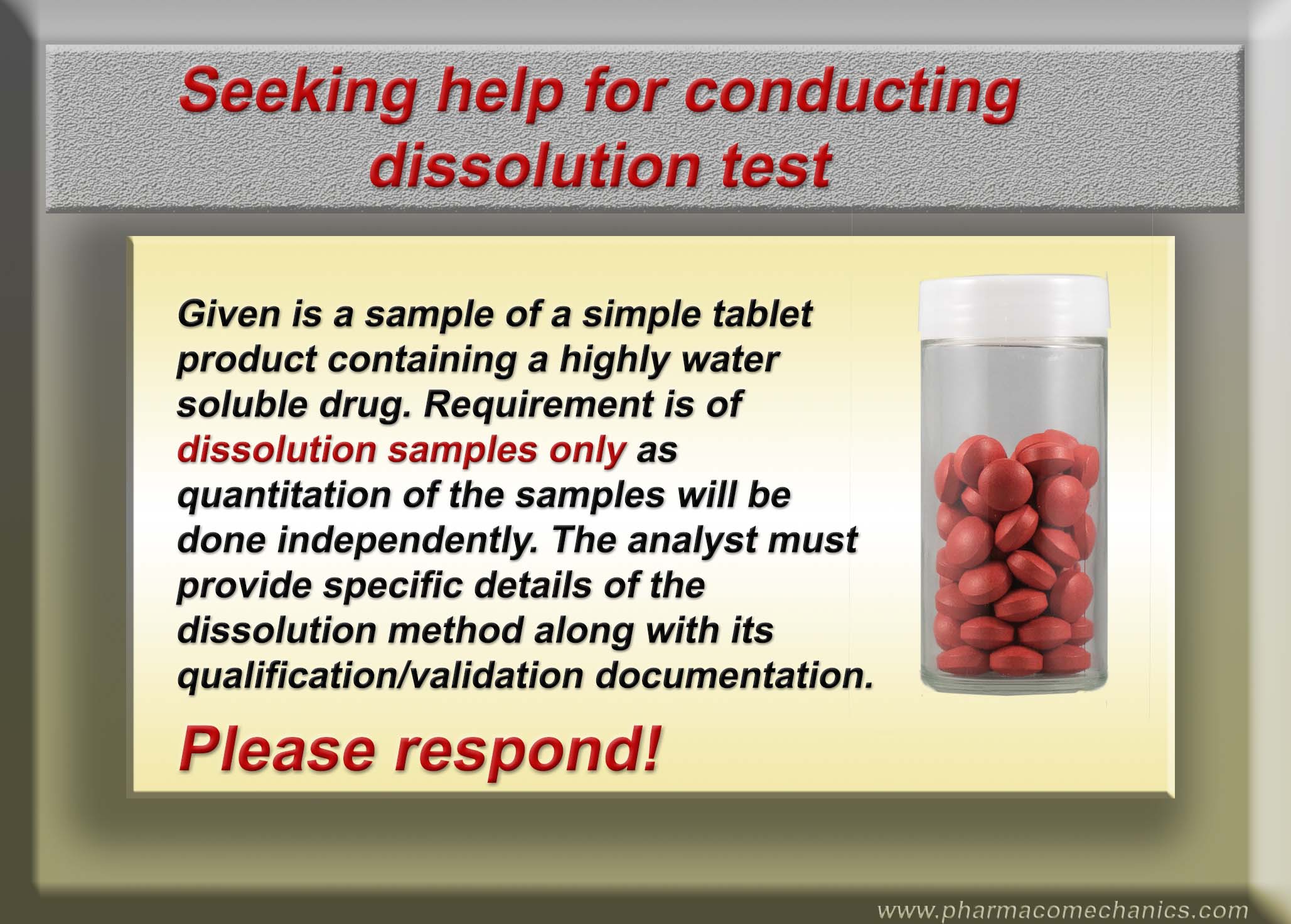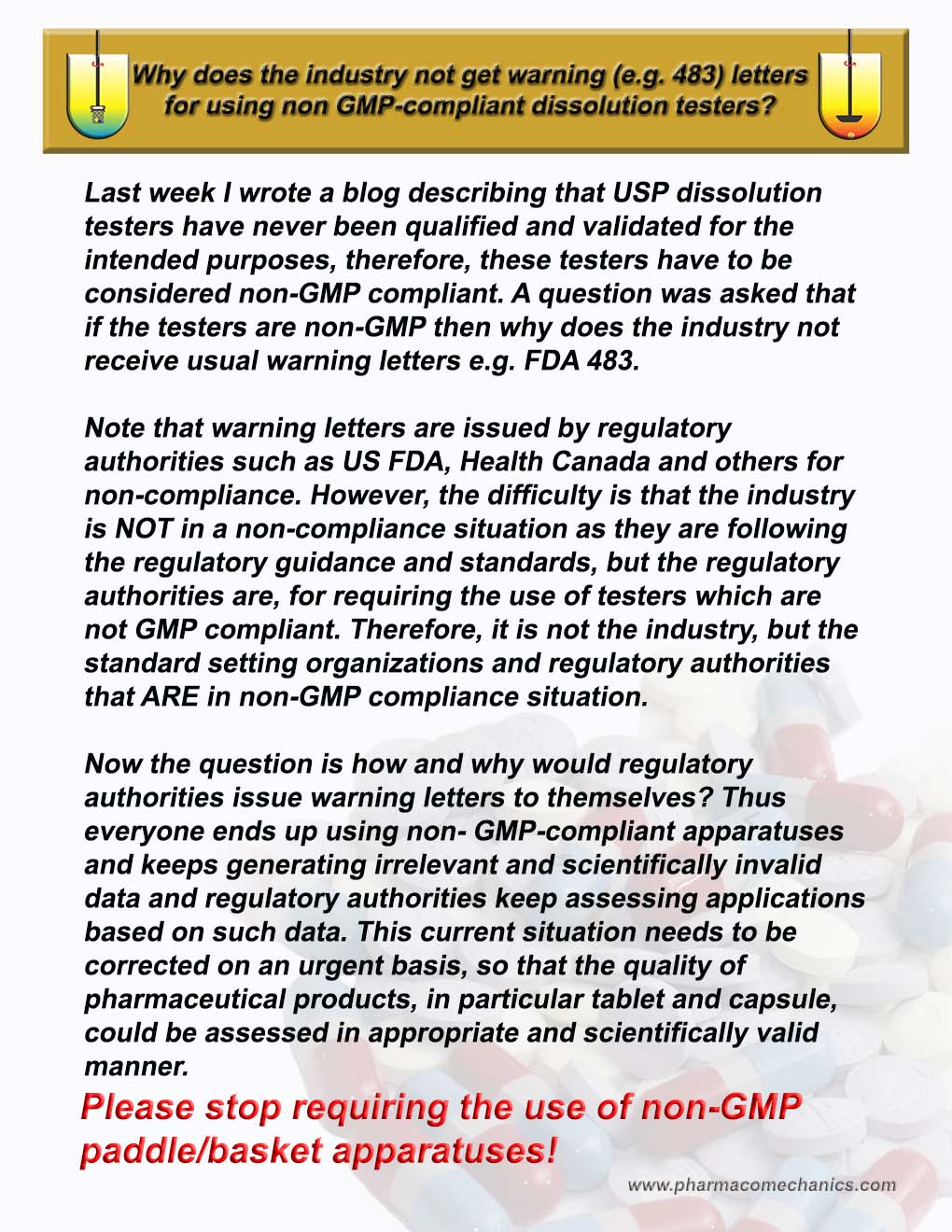Monthly Archives: August 2016
Inspections and quality of pharmaceutical products and/or manufacturing processes – dilemma!
Link for relevant discussion (1)
A recent query!
Question:
How i can enhance Pioglitazone Hydrochloride dissolution profile results in combination with metformin HCl tablet ????
My response:
It is a common question/issue i.e. people ask that they do not observe expected or desired drug dissolution characteristics of a product, but faster or slower. The simple and direct answer to such a question should be to change/adjust the product formulation/manufacturing attributes accordingly. In fact, that should be the only option or advice provided. Often as one does not know the formulation (usually not disclosed), thus it is impossible for anyone to provide any useful advice in this regard.
On the other hand, at present, formulators have been convinced and/or trained to seek changes or adjustments in the dissolution method itself to obtain the characteristics they like to see. Such a practice of dissolution method adjustments are commonly promoted as science and method development practices. I call this as “Fashionable Nonsense”, as this practice is neither scientifically valid nor of any practical use (link). So please avoid such a practice.
To address such a problem/question, I would ask how you would know that your dissolution observations/results are correct. Is your method capable of providing accurate and/or valid dissolution results? That is, is the method you used has been validated to determine dissolution characteristics of a product? The answer is NO, i.e., none of the testers/methods, as recommended at present, are qualified and/or validated for dissolution testing. Thus, one cannot determine dissolution characteristics of any product (link). The dissolution results what you are seeing are simply an illusion, not actual or true dissolution characteristics of the product. Therefore, it is not possible to address the problem using currently recommended testers/methods. This is hard to believe but it is a scientific fact.
Considering this background, I have suggested a modified stirrer, known as crescent-shape spindle, based tester which addresses the issues and provide far better dissolution testing and product characterization. You may read the details about it here. If you require further information, I will be happy explain it further.
Best of luck!
Scientifically speaking!
Link for relevant discussion (1)
Fashionable Nonsense
Drug Dissolution Testing – A Query
You may send your response to principal@pharmacomechanics.com
Using techniques, such as IVIVC, PBPK, and/or other sophisticated statistical analyses, to show validation of dissolution testers and/or their ability to predict in vivo performance is a false science and of no practical use
It is often argued that validation of dissolution tests/testers can be, or have been, achieved using IVIVC based on convolution/deconvolution (CON/DECON) methods, and more recently applying PBPK (Physiologically Based Pharmacokinetic) modelling/simulation techniques. Unfortunately, this is scientifically incorrect and an invalid view and practice.
In reality, CON/DECON and PBPK techniques are mathematical/statistical techniques which use in vitro and in vivo results obtained experimentally. While applying the mathematical techniques, mathematicians/statisticians make a fundamental assumption that the data/results provided to them are relevant and valid, obviously obtained using qualified and/or validated tests and testers. It is the analytical laboratory which ensures that the results were obtained using qualified and validated tests and testers. The important thing to note here is that CON/DECON and PBPK are applications, mostly software, used to transform in vitro results into in vivo. They are not to show or prove that testers/tests used were validated or qualified, but work on the assumption that testers/tests were appropriately validated. Stating that CON/DECON or PBPK techniques establish that dissolution results were obtained using validated/qualified tests/testers is scientifically invalid view and unfortunately reflects misunderstood concept of the mathematical/statistical techniques applied.
It is of utmost importance to note that before using dissolution results for any purpose – eyeballing, similarity factor, tolerances setting, QC/QA, CON/DECON, PBPK or any other sophisticated statistical analyses – one has to establish that results obtained were from qualified or validated tests/testers. This qualification/validation has to be done PRIOR and INDEPENDENTLY, and not using products under development or assessment. If dissolution testers provide irrelevant and erratic results, which they do especially paddle and basket, then any modelling or statistical technique will not help in getting relevant results or correcting the problem. It will be complete waste of time and resources. One must first focus on developing and using qualified and validated dissolution testers.
In short, as the currently recommended testers have never been qualified and validated independently, thus use of techniques mentioned such as CON/DECON, PBPK, simulation/modelling, and other statistical analyses, becomes void and are of no practical use. Therefore, one must first focus on establishing or developing qualified and validated dissolution testers, if valid and successful use of IVIVC or PBPK is desired
Validation of dissolution results and/or testers with exotic data manipulation exercises!
Following is response to a question/concern I posted on LinkedIn Forum. I hope you as visitor to this blog may find it useful as well. Saeed
Question:
You are always asking for references – so here is a recent example linking in vitro to in vivo that was accepted by the regulatory agencies. If the testers are not validated and non qualifed then this work would not work – but it does. Hence your arguments are nonsense as I can link in vitro to PK using the testers plus PBPK modelling. http://pubs.acs.org/doi/abs/10.1021/acs.molpharmaceut.6b00497
My response:
James: I am sorry to say that you are not following the question/concern or the science of dissolution testing. You are just trying to be bullying. Let me explain: (my comments are based on the content of the abstract, as I do not have access to complete paper. I am assuming the tests were conducted using paddle apparatus. If you desire a detailed analysis or response then please provide me a copy of the publication. Furthermore, I do see some specific flaws in the interpretation/conclusions; however, my comments are of general nature describing publications such as the one you cited.)
What is described in the publication is a typical example of matching in vitro and in vivo outcomes, which are not that uncommon in literature. Note I am using the word “matching” not correlation or validation. What people are doing and fooling others, including you, is calling “matching” and “association” of results as “correlation” or “prediction”, which is incorrect and unfortunate. There is no need to have such results from a dissolution tester, one can use anything from lab stirring bar to kitchen food processor to obtain some dissolution results (of course by adjusting experimental conditions) and match them with any of the outcomes, maybe drug levels in blood, air, space or Mars. I am almost certain that you would not follow/understand the mathematical “rituals” people use to come up with expected or desired results to impress others like you and peers. I am not impressed.
To address the question/concern, to obtain some relevancy or predictability of exercise, one has to start with a question, is the dissolution tester used to generate dissolution results is capable of providing “relevant” and “reproducible” results. Once, it is established, and then one has to ask the question, is the tester, after showing the capability relevancy and reproducibility, capable of providing relevant “in vivo” dissolution results. That will be called the “qualification” and “validation” of the dissolution testers. Now you should take this data and start relating to blood/plasma levels, using again scientifically and mathematically valid models (note that even the mathematical modelling will require its own independent validation before applying for such correlation or prediction). I will be happy to discuss this in further details if so desired. There is no qualification or validation is available here, in particular for dissolution testing, so the question/concern remains.
In short, anyone can obtain some numbers and mix them with mathematical equations to get any results one wants or likes. However, to be valid, they require prior validation, which is missing, in particular for dissolution testers and results. No question about that. You, and others, like to call this exercise modelling, simulation and validation and you are free to call anything you like. To me, it is just jugglery with numbers, thus has no scientific merit, credibility or use. Sorry!
Using Crescent-shape spindle for different dosage forms and suggestion of a “standard” tablet product
The following is a response to a question on LinkedIn Forum, which, I thought, would be valuable to the visitors of this blog as well. I hope you will find it useful. Saeed
Question:
Saeed: Aside from the fact that cGMP is commonly understood as the current norms of industry, would you advise on how your approach would apply to other dosage forms? The maceration/muddling/contact mixing apparatus you’ve designed might be able to replace paddles and baskets for tablets. What would be the solution for testing of sublingual and transdermal films using paddle over disk or cylinders? If you feel that performance verification is necessary (running a “standard” product), wouldn’t you provide a better service to industry by developing a better “standard” product than the Prednisone PVT tablets?
My response:
Louis: Excellent questions. I personally believe that dissolution testing is, and should be, for oral products only. The dissolution tests mimic volume/space, liquid, stirring/mixing, and temperature of the GI tract, in particular intestinal. Other than stirring/mixing environment these apparatuses (paddle/basket) are fine. As the paddle/basket do not provide appropriate stirring/mixing but stagnation, and also highly variable results because of variable settling positions of tablets/capsules at the bottom vessel, they do not mimic GI environment appropriately, thus are not suitable for dissolution testing. Crescent shape spindle addresses these flaws therefore offer better mimicking of GI tract and thus dissolution testing. The reason I explained this is that there is science and logical thinking behind the development and suggestion of the crescent shape spindle. It is not like that OK if paddle/basket does not provide expected results try something else without looking and addressing the cause of the problem.
With this background, my view about sublingual products is that you may try and it might work. As I do not have experience working with such products I can only envision that the crescent shape spindle might provide faster dissolution results than what one would observe in vivo as in in vivo tablets move slower than in vitro with the crescent shape spindle. But then one should be able to conduct dissolution at a lower rpm say 5 for such products. Certainly, you should try.
Concerning patches or other dermal/topical products, I do not think that dissolution testers (paddle/basket or crescent shape spindle) should be used at all. There is no link or simulation of in vivo environment here for such products i.e. science does not support such testing. However, if one insists on using it for some reason, then one may use the same setup for patches with disk and hang it in the vessel from the lid of the vessel or tie it to the rod of the spindle. Most likely results will be better than using paddle/basket as crescent shape spindle provides much better mixing environment.
Concerning developing “standard” tablets, I would not develop standard tablets, like PVT which in my view was a wrong concept. Tablets do not, and cannot, reflect deficiencies of the individual physical parameters of testers and/or tests. The “standard” tablets are only be used to show that, AFTER meeting all the physical specifications collectvely, the tester is “performing” well, i.e. capable of providing expected dissolution results of a PRODUCT for human use (not just any tablets or product). Therefore, I have some ideas of picking up a product, as a “standard” in this regard. I am looking for a product manufacturer who would be interested in working with me for the selection of such a product. So, anyone interested in such (lucrative) work or market, please contact me. I believe it would be a small and short project with big financial reward and service to pharmaceutical industry.
I hope I have answered your questions adequately. Let me know if you require further details.





